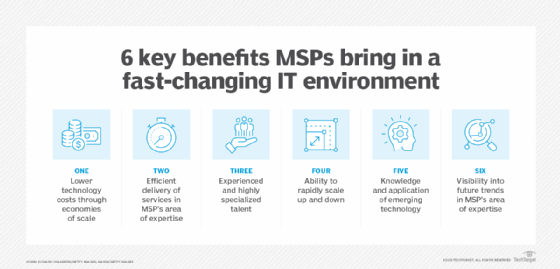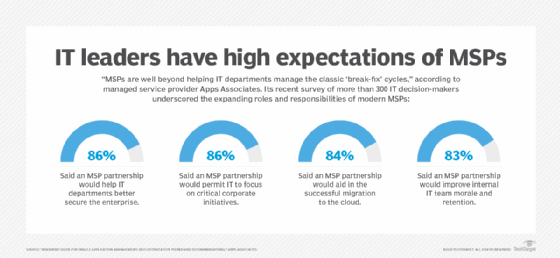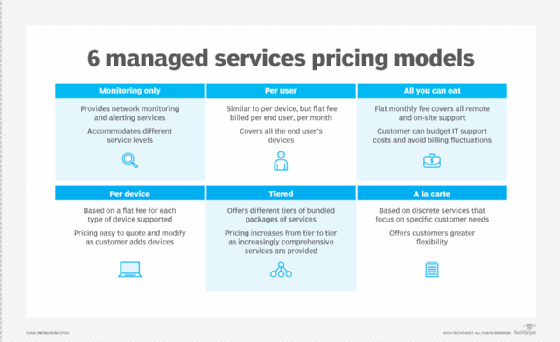How Do Managed Services Differ From Restaurants
What is a managed service provider?
A managed service provider (MSP) is a third-party company that remotely manages a customer'due south it (Information technology) infrastructure and stop-user systems. Small and medium-sized businesses (SMBs), nonprofits and government agencies hire MSPs to perform a defined set of day-to-solar day management services. These services may include network and infrastructure management, security and monitoring.
MSPs often handle management services on a daily footing and then customer organizations can focus on improving their services without worrying virtually extended system downtimes or service interruptions.
While some MSPs may specialize in specific segments of It, such as information storage, others focus on specific vertical markets, such every bit legal, financial services, healthcare or manufacturing. Managed security service providers, for instance, offer specialized types of services, such as remote firewall administration and other security-as-a-service offerings. Managed print service providers maintain printers and supply consumables. Often, MSPs perform their tasks remotely over the cyberspace.

The evolution of MSPs began in the 1990s with the emergence of application service providers (ASPs), which offered a level of service for remote application hosting. ASPs helped pave the style for cloud calculating and companies that would provide remote support for customers' It infrastructure. MSPs initially focused on the remote monitoring and direction (RMM) of servers and networks. Over time, they accept expanded the scope of their services equally a way to differentiate themselves from other providers.
Today, the terms deject service provider and managed service provider are sometimes used synonymously when the provider's service is supported past a service-level understanding (SLA) and is delivered over the cyberspace.
What are MSPs used for?
Hiring a managed service provider can help an system better its operations.
SMBs are typical MSP customers. Many smaller companies have express in-house IT capabilities, so they may view an MSP's service offer every bit a style to obtain It expertise. Just larger enterprises may likewise contract with MSPs. For example, government agencies facing budget pressures and hiring limitations may contract with an MSP to supplement their in-house IT staff.
MSPs handle the complex, consuming or repetitive work involved in the direction of It infrastructure or terminate-user systems. MSPs typically do the following:
- handle the management of It infrastructure;
- offer technical back up to staff;
- add cybersecurity software to IT;
- manage user access accounts;
- handle contract management;
- offer compliance and risk direction; and
- provide payroll services.
How exercise MSPs piece of work?
When a managed service provider is requested to come across the concern objectives of an organization, it is ofttimes expected to fill in some gap or role in an IT organisation or staff. Advice between the MSP and the organisation typically begins with an assessment that determines the organization's current environment. This cess may betoken out potential room for improvement and how to properly back up business goals.
There is not 1 specific setup for every arrangement, and then an MSP may provide many different service options. Two examples of MSP offerings are technical support fix services and subscription services.
MSP technical support fix services focus on remotely fixing or sending technicians to a business'due south location to resolve any issues. MSPs that provide this option charge the company for the time spent troubleshooting and for whatever parts used to repair the problem.
MSPs that offering a subscription service model work on the quality of service of an organisation's network and usually nib customers monthly. If an result arises, the MSP volition fix the trouble as part of the agreement between the organisation and the MSP. Payment through the subscription model is based on defined rates per computer or equipment.
Maintenance, security, monitoring, reporting and other services are defined using an SLA that documents what the arrangement tin can look from the MSP. Response times, performance and security specifications are also included in the service agreement.
MSPs may deliver their own native services, other providers' services or an integrated mix of the ii. Pure-play MSPs specifically focus on i vendor or technology and more commonly offer their own native services.
MSPs also focus on deploying specialist software platforms that automatically manage functions. These platforms consist of RMM tools and professional services automation (PSA) applications:
- RMM software enables off-site technicians to maintain IT systems, such as networks, servers, desktops and mobile devices. These tools too enable MSPs to apply patches and other system updates.
- PSA tools enable an MSP to manage an organization's projects, billing, avails and inventory.

A managed service provider oft provides its service offering under an SLA -- a contractual system between the MSP and its customer. The SLA spells out the performance and quality metrics that govern the human relationship. Organizations demand to be precise when agreeing on the commitments they brand in SLA contracts.
An SLA may exist linked to an MSP's pricing formula. For example, an MSP may offering a range of SLAs to customers, with the client paying a higher fee for higher levels of service in a tiered pricing construction.
What are the types of MSPs?
The types of managed service providers can differ depending on the criteria chosen to categorize them. For example, if a business chooses to organize MSPs by the size of their target customers and how much responsibleness they take on, MSPs tin can exist organized in the post-obit way:
- Pure-play MSPs. These tend to be smaller providers that focus on monitoring networks and awarding functioning. They offer their own native services that focus mainly on reporting and alerts.
- Staffing legacy MSPs. These MSPs generally target midlevel organizations and Fortune 500 companies and oftentimes offer a wide range of services, including monitoring, reporting, and software installation and upgrades.
- High-level MSPs. These consist of small and large providers that enable their clients to outsource as much of their IT processes as needed. Typically, high-level MSPs offer a wide range of services.
MSPs can as well be categorized by the type of services they offer:
- Monitoring. These MSPs offer existent-time monitoring software for dissimilar applications, network devices, servers or websites.
- Remote back up. These MSPs offering deject-based software, back up remote devices and remotely troubleshoot technical problems.
- Proactive support. These MSPs perform preventative maintenance to stay ahead of whatever device or network issues that could arise.
- Centralized direction. These MSPs provide a management console for complex networks, remote monitoring, patch management and security software.
- Scheduled maintenance. These MSPs offer organizations regularly scheduled network maintenance.
- Simplified billing. These MSPs handle invoicing, payments and budgeting via a billing direction system.
What are the benefits of managed service providers?
Benefits of managed service providers include the following:
- Assistance an organisation fill staff shortages. If an organisation lacks workers, it can outsource some of its tasks to the MSP.
- Provide expertise. Hiring a reputable MSP provides an organization with access to expert resources.
- Provide business concern continuity. An SLA documents the MSP's obligations to the business to prepare for or recover from a disaster.
- Provide constant network monitoring. Many MSPs offering 24/7 monitoring services using network monitoring tools that offer system visibility and cloud direction.
- Improve security. Some MSPs provide security software and awareness training.
- Improve cost efficiency. If numerous unplanned repairs are needed, paying a fixed monthly charge can be more than cost-constructive than paying hourly. While the MSP handles the 24-hour interval-to-day management services, customer organizations tin can focus on improving their services.

What are the challenges of managed service providers?
Despite their advantages, managed service providers may also come with challenges, for example:
- Not all MSPs offer security measures. Many MSPs do non take a major focus on cybersecurity.
- Dependent on third-political party organizations. Organizations that depend on an MSP to handle daily tasks may form a reliance on them. If the MSP fails to follow through on the SLA, the system could experience organization downtime.
- Waiting on a response. It may have time for an MSP to answer to an issue.
- Potential upselling. An MSP may try and upsell an organization on applied science or services they do not demand.
- Inaccessible data. An organization'due south information may not be freely attainable if the MSP is using a proprietary tool to manage and monitor its infrastructure.
What is the pricing model for managed service providers?
Managed service providers typically use i of the post-obit pricing models:
- Per-device pricing. The MSP charges the customer a apartment fee for each device it manages.
- Per-user pricing. The MSP charges a flat fee for each user, accommodating users who utilize multiple devices.
- All-inclusive pricing. Too referred to as theall-you lot-can-consume model, the MSP charges a flat fee for its It infrastructure support and management services.
- Tiered pricing. Organizations can choose the bundle of services that all-time fits their needs. This is typically a favored pricing model for MSPs.
- Monitoring-only pricing. MSPs only offering monitoring and alerting services for an organization'due south IT infrastructure.

In each of these pricing approaches, the client pays the flat fee on a regularly scheduled basis, often monthly. Such pricing methods permit MSPs sell services under a subscription model. This arroyo provides the MSP with a monthly recurring revenue (MRR) stream, in contrast to It projects that tend to be quondam transactions.
MRR differs from other business organisation models, equally providers pursuing the break/fix model, for example, usually price their services on a fourth dimension and materials basis. They mostly bill an hourly rate for repairing a client's Information technology equipment and charge for parts or replacement gear.
Larn what MSP trends are expected to shape the yr and set the stage for the ongoing development of other technologies, including deject computing.
This was final updated in August 2021
Continue Reading Nearly managed service provider (MSP)
- How to transform your existing MSP and be more competitive
- MSP roles and responsibilities are undergoing rapid change -- hither'southward why
- Do brands managed service providers use matter to customers?
- The reality of starting an MSP and what to know before launch
- Running An MSP In 2020: Primal Takeaways For Future MSPs
Dig Deeper on MSP business organisation strategy
-

MSPs find soft-skill, tech challenges in assistance desk-bound ticketing
-
![]()
The value of the managed service provider
-

Outcome-based contracts: Be careful what y'all wish for
-

Guide to building and executing an MSP business organization model
How Do Managed Services Differ From Restaurants,
Source: https://www.techtarget.com/searchitchannel/definition/managed-service-provider
Posted by: singletonalreend.blogspot.com





0 Response to "How Do Managed Services Differ From Restaurants"
Post a Comment